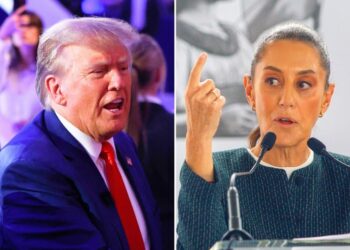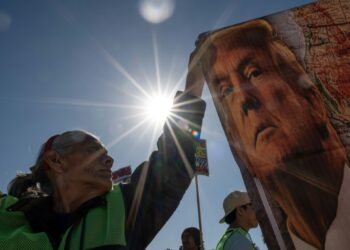“I had to take executive action,” President Joe Biden claimed well after midnight on the first night of the Democratic National Convention. “As a result of the executive action I took, border encounters have dropped over 50%. In fact, there are fewer border crossings today than when Donald Trump left office.”
Almost everything Biden said that night is, of course, false.
Biden did take executive action, that much is true. In June, he changed how migrants were processed when arrested, requiring them to affirmatively claim fear of being returned to their home country instead of Border Patrol agents just assuming everyone who was arrested wanted to claim asylum.
And southwest land border encounters did drop from 130,416 in June to 104,116 in July. But that is a 20% drop, not a 50% drop. And the 104,116 border encounters in July is still 30,000 higher than the 73,994 migrants encountered in December 2020, former President Donald Trump’s last full month in office.
If we look back further, the drop in illegal immigrants crossing the southern border is more dramatic. In December 2023, a record-high 301,981 migrants were encountered at the southern border. But that number fell to 176,196 in January, five months before Biden took executive action. And after a small bump back up to 189,913 in February, the number of migrants illegally crossing the southern border has fallen ever since.
Something did happen on the border between December 2023 and today. Southern border crossings have fallen 65%. But almost 90% of the border crossing reduction we’ve seen since December came before Biden took executive action, not after. So unless Biden has also invented time travel, something other than his executive action drove those numbers down. But what?
The answer can be found almost 1,000 miles away from the United States border in Villahermosa, the capital of the southern Mexican state of Tabasco.
“The migrants arrive here in a complete state of shock,” Karina del Carmen Vidal, the manager of a 160-person migrant shelter in Villahermosa, told the New York Times in May, a month before Biden announced his executive order.
In January, just weeks after Secretary of State Antony Blinken and Homeland Security Secretary Alejandro Mayorkas met with Mexican President Andrés Manuel López Obrador, Mexican law enforcement officials began detaining migrants in cities close to the U.S. border, forcing them onto buses, and then sending those buses far south into Mexico. Most of them end up in Villahermosa.
“I asked the agents, ‘How can you treat us like dirt?’” Rosa Guamán, a migrant from Ecuador, told reporters after Mexican officials detained her, her husband, and her two children in Piedras Negras, a Mexican city just across the border from Eagle Pass, Texas. Nobody told Guamán, her family, or any of the other migrants on the bus where they were going. She arrived in Villahermosa in April. She has no legal status in Mexico. She has no idea what she will do next. And she is not alone.
The Mexican government never officially announced the new busing program or shared any details with the public. International nongovernmental organizations estimate that over 100,000 migrants have been bused south from the U.S. border through the program, which also includes checkpoints along all major highways heading north. López Obrador’s government has also severely cut back on the number of “humanitarian visas” granted to migrants crossing its southern border who intend to travel to the U.S.
None of these new policies have been explained publicly. They just all suddenly materialized in January after Blinken and Mayorkas met with López Obrador in the days following Christmas.
A joint communique issued by the governments of the U.S. and Mexico after the Blinken-Mayorkas meeting with López Obrador on Dec. 28, 2023, reads, “The two countries reaffirmed their existing commitments on fostering an orderly, humane, and regular migration,” and that “ongoing cooperation” between the two countries included “enhanced efforts to disrupt human smuggling, trafficking, and criminal networks.” But there is no mention of a “deal” or an “agreement” for new enforcement measures by Mexico. The statement definitely does not say anything about a massive new effort by Mexico to bus migrants south.
López Obrador later posted on X that “important agreements were reached for the benefit of our people and nations,” but no details were given.
What we do know from later reporting is that López Obrador asked Biden to wait to announce his executive order on immigration until after the Mexican presidential election on June 2. And that is exactly what Biden did. What we do not know is if Mexico made any similar promise regarding the U.S. presidential election.
López Obrador has been highly critical of Trump and the Republican Party in the past, and it is no secret that his government wants the Democrats to win the next election. “Some Republicans use the immigration issue for electoral and political purposes,” López Obrador said in May, echoing Democratic Party talking points.
Clearly some agreement was struck between Blinken, Mayorkas, and López Obrador that Christmas week, but it does not appear voters will be told what was in the deal or how long the deal is supposed to last. An anonymous White House official did tell the New York Times that, “the U.S. does not dictate what measures Mexico should take to curb migration.” But whatever vague terms the Mexican government agreed to, they are definitely following through.
For those concerned with border security, the question is just how long the Mexican busing program will continue. There are already signs that it is not sustainable.
While the Mexican government may be apprehending record numbers of migrants both at the U.S. border and along highways throughout the country, the country’s official deportation border numbers have not gone up. Mexico is keeping the migrants out of the U.S. but they are not removing them from Mexico.
And the flood of migrants from around the world seeking to enter the U.S. keeps coming. Over 170,000 migrants have crossed the perilous Darian Gap separating Panama and Colombia on their way to Mexico through June, a 2% increase over last year.
With Mexican law enforcement busing migrants away from the U.S. while still letting more migrants enter the country’s southern border, all without increasing deportations, the migrant population within Mexico is growing, and even López Obrador strongholds such as Villahermosa won’t tolerate the burden forever.
Like U.S. cities burdened by Biden’s border crisis, the sidewalks of Villahermosa are filled with homeless migrants sleeping outside without any shelter. Small children beg locals for money along with their desperate parents. And crime is rising. Local news has fixated on stories of migrants stealing mobile phones and assaulting bus drivers.
“No, Father, we don’t want migrants here,” parishioners told Roman Catholic priest Roberto Valencia Aguirre when he announced plans to open a shelter in a wealthier neighborhood of Villahermosa. The political will needed to keep the lid on López Obrador’s migrant busing won’t last forever and probably is not intended to last past November.
***
From January 2021, when Biden’s first executive orders halting deportations and ending Trump’s Remain in Mexico program caused an immediate spike in illegal border crossings, until just this year, the Democratic Party completely denied the existence of the president’s border crisis.
At first, Biden said the spike in illegal immigration was “seasonal” and “happens every single solitary year.” As his border crisis persisted across the seasons, the Democratic Party’s talking points changed, with Mayorkas settling on the phrase “significant challenge” as the way to characterize the record-high numbers of illegal immigrants being caught and released into the country.
It wasn’t until April, more than three months after his secret deal with Mexico, that Mayorkas finally admitted under oath what the vast majority of people had known for years: There is a crisis on our southern border.
For now, the immediate crisis seems to have slowed. Border crossings are still higher now than they were under Trump, but they are down significantly since the record highs of last December. This does not change the fact that, thanks to Biden’s catch-and-release policies, the number of illegal immigrants in the U.S. has increased by 4 million under his watch.
CLICK HERE TO READ MORE FROM THE WASHINGTON EXAMINER
As big a problem as those extra 4 million illegal immigrants are, however, the arguably bigger problem is what happens to the Democratic Party’s secret border deal with Mexico after Election Day. If Trump wins, the deal will surely be off. But he has a proven track record of using the full power of the U.S. government to force Mexico into taking back migrants while their asylum cases are heard.
But if Vice President Kamala Harris wins, all bets are off. The Lankford-Mayorkas border bill she supports codifies Biden’s illegal catch-and-release policies. She has said she supports decriminalizing unauthorized border crossings. If Mexico releases the growing pressure on its own migrant crisis and stops busing migrants south, the border will slip into chaos again. And there is nothing in Harris’s record to suggest she will do anything to stop the explosion.
Source link : http://www.bing.com/news/apiclick.aspx?ref=FexRss&aid=&tid=66ccd8799b924a98afe901ccd32558b8&url=https%3A%2F%2Fwww.washingtonexaminer.com%2Fopinion%2Fcolumnists%2F3134028%2Fdemocratic-party-secret-border-deal-mexico%2F&c=1820081617700440896&mkt=en-us
Author :
Publish date : 2024-08-26 07:54:00
Copyright for syndicated content belongs to the linked Source.







